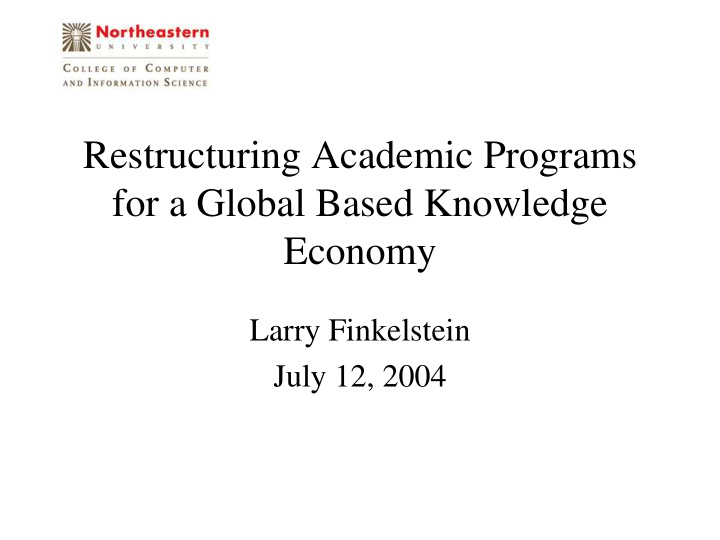



Restructuring Academic Programs for a Global Based Knowledge Economy Larry Finkelstein July 12, 2004
Changing World • The world is changing: – Our students will graduate into a knowledge based global economy – Working in an international context will be normal – It is expected that you will have multiple jobs during lifetime – “Everything you put on a wire is up for grabs”, Nandan Nilekani, CEO Infosys (at WEF 2004) – "There is no job that is America's God-given right anymore," Carly Fiorina, Hewlett-Packard CEO
Universities are Responding • Leading universities are reviewing their core curriculum to fit the changing world. • Hallmarks of the new core curriculum – International studies – Thorough education in the Sciences – Core courses to broaden students’ experience, expand their horizons, introduce bodies of knowledge, concepts and major texts. – Majors should contain fewer requirements – Expanded range of capstone experiences – Interdisciplinary Studies
Are Students Responding?
Freshman Majors Chronicle of Higher Ed Survey 18 16 14 12 10 2000-01 2001-02 2002-03 8 2003-04 6 4 2 0 Business Arts & Professional Education Social Engineering Biological Physical Computer Undecided Humanities Fields Sciences Sciences Science Science
What Does the Data Say? • Freshman choices are relatively stable except for % of students choosing CS 4 3.5 3 2.5 Computer Science 2 1.5 1 0.5 0 2000-01 2001-02 2002-03 2003-04
How Is the Discipline Responding? • On the research side: – An increasingly expanded view of the discipline of computing to include engagement with application domains which have important science/societal impact. [See J. Foley CRN article] – This is essentially a continuation of the direction set by the 1992 CTSB publication “Computing the Future” by Hartmanis and Lin
How Are Academic Units Responding • Broadening the base of undergraduate programs: – Computer Science – Software Engineering – Information Science – Information Systems – Informatics – Information Technology – ….. • Forming Standalone Colleges – The IT Dean’s group sponsored by CRA now has approximately 40 members
Are We Getting it Right? • Are our academic programs in alignment with our research agendas? – Interdisciplinary is a core value of the expanded view of computing, but occurs primarily at the research level. • Do our current programs provide students with an intellectual framework for future growth in a knowledge based global economy? – How will these adapt to rapidly changing times? • How do we articulate a broader view of computing to high school students? – The distinction is often subtle and students don’t have a basis for deciding.
Some Personal Reflections • Students are uncertain about the future and want to delay committing to a major. • Being good technically will be necessary but not sufficient to succeed in the world our students will enter. Students will also need: – Good communication skills – especially listening – Deep knowledge of an application domain – Understanding of the business context – Learning how to be effective in a team project
NU Experience • Have a standalone College of Computer and Information Science • Required co-op program provides real world experiences that are hard to teach in a formal classroom. • Two core degree programs: – Computer Science, Information Science • An approved template for forming dual degree programs with other disciplines – Dual majors consist of about 2/3 of a major in each discipline together with some “glue” courses – Provide students with significant understanding of an application domain • Duals currently exist with the sciences and mathematics, will shortly be approved with the digital arts and are being explored with business. – About 12% of all students are currently doing dual degrees.
Case Study (Steve Lohr, NYT, 2/15/04) • The people in demand, says Hershel Harris, vice president for strategy in I.BM.'s software unit, are those who are fluent in technology and in how technology can be applied to solve problems in particular fields of business or science. • The result is new hiring, even as other jobs move offshore. – Intel has added 1,000 software engineers in China and India in the last two years, but it has added even greater numbers in the US – IBM is also doing both. The company says it plans to transfer 3,000 jobs overseas, but also says it intends to add 4,500 employees this year in the United States, including programmers and software designers with specialized skills.
Recommend
More recommend